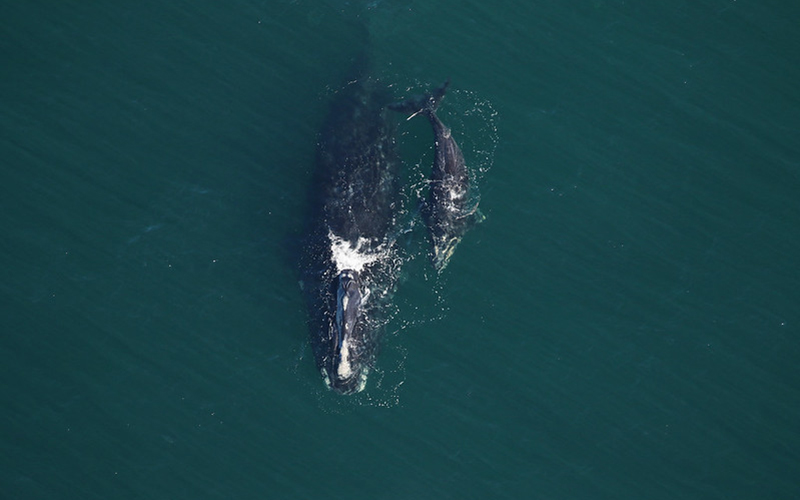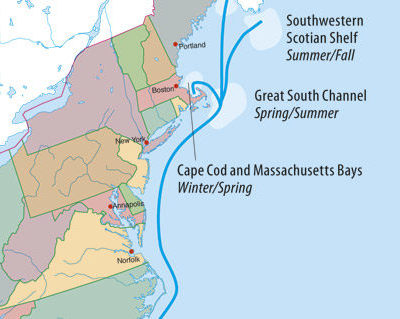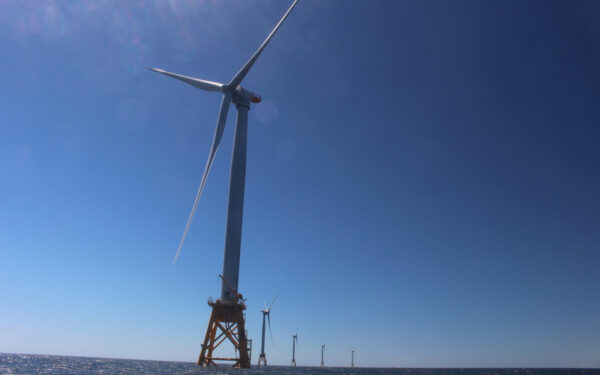
Under a historic agreement, offshore wind developer Vineyard Wind will institute a variety of protective measures to keep right whales safe while installing and operating turbines at its project off the coast of Massachusetts. Photo: Clearwater Marine Aquarium Research Institute, NOAA permit #20556-01 CC BY-NC-ND 2.0
With sea levels and temperatures rising, it is critical that we develop New England’s renewable wind energy to reduce our use of fossil fuels. Harnessing offshore wind will help the region transition away from dirty polluting fossil fuels to a clean energy economy that safeguards us from the impacts of climate change.
As new offshore wind projects move forward off of New England’s coast, it’s important to bring this exciting new resource online in a way that maintains a healthy ocean.
Part of that balance is ensuring that offshore wind development does not harm our iconic – and severely endangered – North Atlantic right whales. CLF and our partners recently announced a landmark agreement with offshore wind developer Vineyard Wind to make sure that this exciting source of clean energy doesn’t come at the expense of our treasured right whale.
It’s a roadmap for future developers to follow, balancing necessary protections for wildlife with the imperative for renewable energy.
Landmark Agreement Gives Right Whales Needed Protection
Vineyard Wind recently won a contract to install more than 80 turbines approximately 14 miles off the Massachusetts coast. The wind farm will supply 800 megawatts of electricity to New England – enough to power 400,000 homes. This is a major step forward in cutting the region’s dependence on climate-damaging fuels.
CLF has been working to boost clean energy production in the region for years. At the same time, we have been fighting to protect the critically endangered North Atlantic right whale, of which there are only an estimated 411 left on the planet. Under the groundbreaking agreement reached with CLF and our partners Natural Resources Defense Council and National Wildlife Federation, Vineyard Wind has committed to a variety of measures to keep right whales safe during the installation and operation of the massive turbine project.
Right Whales Are Vulnerable to Underwater Noise During Construction
While turbines are being installed, the loud noise caused by pile driving – when holes are bored into the ocean floor to install a turbine’s base – can injure a whale’s hearing system and interfere with its ability to communicate. This ocean noise can also divert right whales from their usual migratory routes or feeding grounds.
When whales swim off their usual route, they can end up in areas that are less abundant for feeding or, worse, veer into the path of passing ships. Ship strikes are the second leading cause of death for right whales after entanglement in fishing gear. Even if a whale avoids such a tragedy, interrupting its regular feeding routine can harm a whale’s overall health, including its ability to reproduce.
The agreement reached with Vineyard Wind will limit turbine construction to times of the year when right whales are least likely to be in the area. Extensive shipboard, aerial, and acoustic monitoring will be used to monitor whether right whales are nearby. When whales are spotted, construction can be delayed or suspended until the whales have left the area. The developers have also agreed to use noise-dampening technologies to avoid injury to right whales and make the installation less disruptive.
The project also will bring an increase in ship traffic as construction and crew transport vessels operate between port and the wind development area. Because right whales spend a lot of time feeding just below the water’s surface, fast-moving ships could strike and severely injure or even kill them. The agreement addresses this risk as well, specifying that ships follow strict speed restrictions and monitoring protocols.
These measures aren’t just beneficial for right whales. Marine mammals in general are sensitive to underwater sound, which can harm their hearing and therefore their ability to navigate and communicate. Reducing construction noise will keep the entire ocean ecosystem healthier, and slower boats mean fewer animals injured by fast-moving ships.
Agreement Builds on CLF’s History of Balancing Ocean Protection, Clean Energy
This isn’t the first time CLF has worked with offshore wind developers to ensure that new projects don’t harm the ocean.
Two years ago, the Block Island Wind Project, the first offshore wind farm in the country, was being developed off the coast of Rhode Island. CLF negotiated an agreement with developer Deepwater Wind, recently acquired by Danish energy giant Orsted, to minimize harm to right whales during its construction. Since the project has been up and running, it has powered all the homes on the island through the coldest winter days.
Prior to that project, we negotiated a 2014 agreement with Deepwater Wind to minimize harm to right whales during site characterization and assessment activities within their larger federal lease area off Massachusetts and Rhode Island.
And the offshore wind market is only heating up. At a recent offshore wind auction, nearly 400,000 acres of ocean waters south of Martha’s Vineyard sold for a record-breaking $405 million.

Future Wind Energy Development Must Consider Right Whales
Fishing gear entanglements and ship strikes cause the majority of right whale deaths today. While offshore wind energy development poses a new risk to this iconic creature, it also presents an opportunity for us to develop a clean energy source that causes minimal harm to the environment.
As the first region to fully embrace and act on offshore wind, New England is writing the handbook for how to harness this natural resource. By taking ocean health into account as we site, build, and operate offshore wind farms, we can create a gold standard for protecting our precious marine life while successfully ending our dependence on dangerous fossil fuels.




